1998 CHEVROLET VENTURE ECU
[x] Cancel search: ECUPage 20 of 474
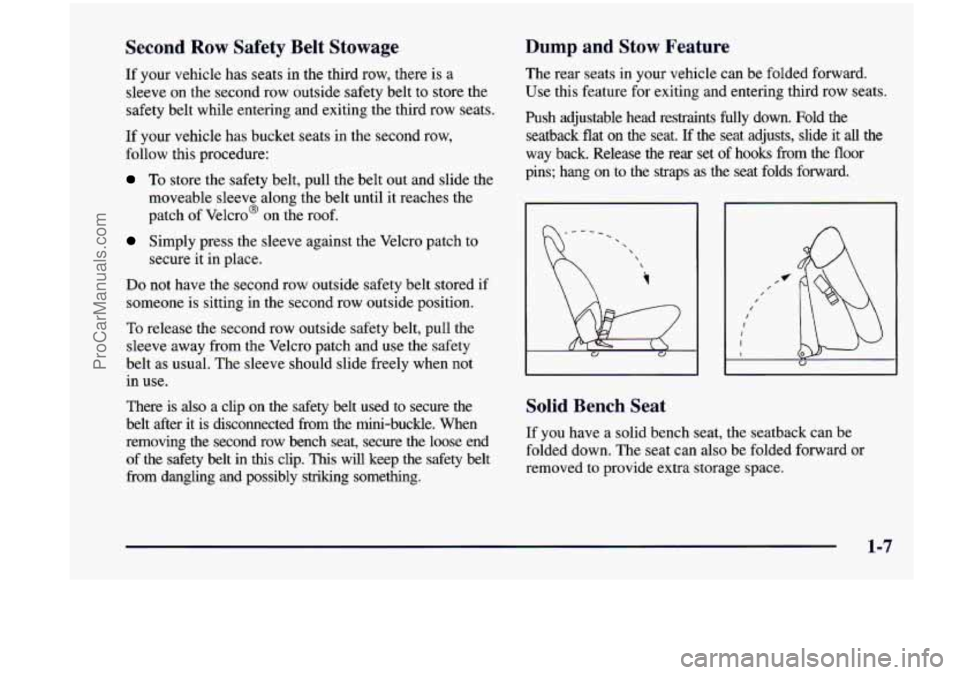
Second Row Safety Belt Stowage Dump and Stow Feature
If your vehicle has seats in the third row, there is a
sleeve
on the second row outside safety belt to store the
safety belt while entering and exiting the third
row seats.
If your vehicle has bucket seats in the second row,
follow this procedure:
To store the safety belt, pull the belt out and slide the
moveable sleeve along the belt until it reaches the
patch of Velcro@ on the roof.
Simply press the sleeve against the Velcro patch to
Do not have the second row outside safety belt stored if
someone is sitting in the second row outside position.
To release the second row outside safety belt, pull the
sleeve away from the Velcro patch and
use the safety
belt
as usual. The sleeve should slide freely when not
in use. secure it in place.
There is
also a clip on the safety belt used to secure the
belt after
it is disconnected from the mini-buckle. When
removing
the second row bench seat, secure the loose end
of the safety belt
in this clip. This will keep the safety belt
fi-om dangling and possibly striking something. The
rear seats in
your vehicle can be folded forward.
Use this feature for exiting and entering third row seats.
Push adjustable head restraints fully
down. Fold the
seatback flat on the seat.
If the seat adjusts, slide it all the
way back. Release
the rear set of hooks from the floor
pins; hang on to the straps as the seat folds forward.
I I I I I
Solid Bench Seat
If you have a solid bench seat, the seatback can be
folded down. The seat can also be folded forward or
removed
to provide extra storage space.
1-7
ProCarManuals.com
Page 55 of 474
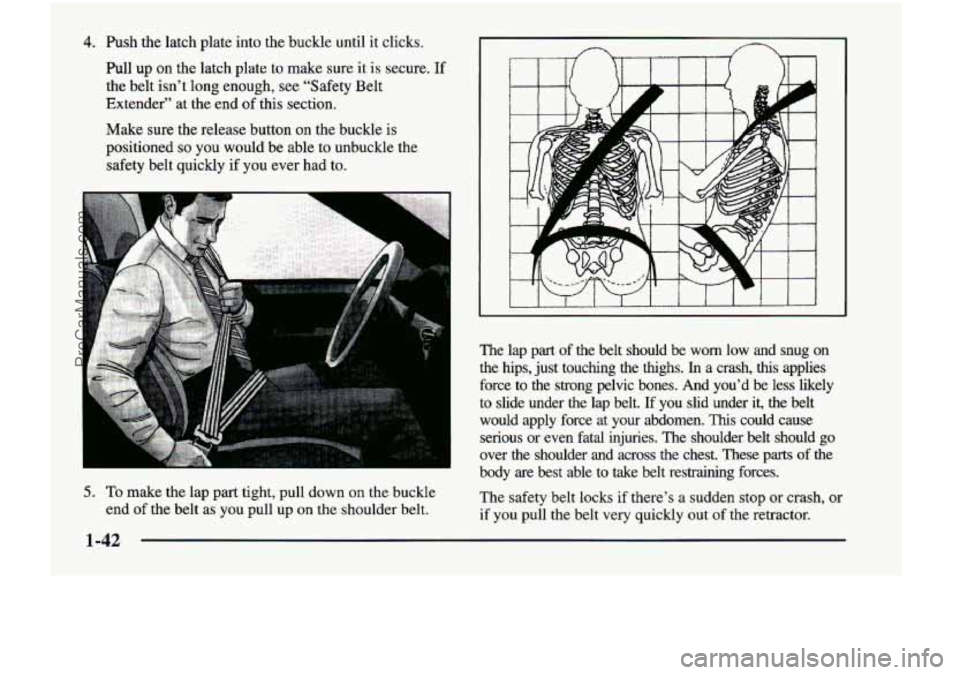
4. Push the latch plate into the buckle until it clicks.
Pull
up on the latch plate to make sure it is secure. If
the belt isn’t long enough, see “Safety Belt
Extender” at the end
of this section.
Make sure the release button on the buckle is
positioned
so you would be able to unbuckle the
safety belt quickly if you ever had to.
5. To make the lap part tight, pull down on the buckle
end
of the belt as you pull up on the shoulder belt. The lap
part of the belt should be worn low and snug on
the hips, just touching the thighs.
In a crash, this applies
force to the strong pelvic bones. And you’d be less likely \
to slide under the lap belt. If you slid under it, the belt \
would apply force at your abdomen.
This could cause
serious or even fatal injuries. The shoulder belt should go
over the shoulder and across the chest. These
parts of the
body
are best able to take belt restraining forces.
The safety belt locks if there’s a sudden stop or crash, or
if you pull the belt very quickly out of the retractor.
1-42
ProCarManuals.com
Page 64 of 474
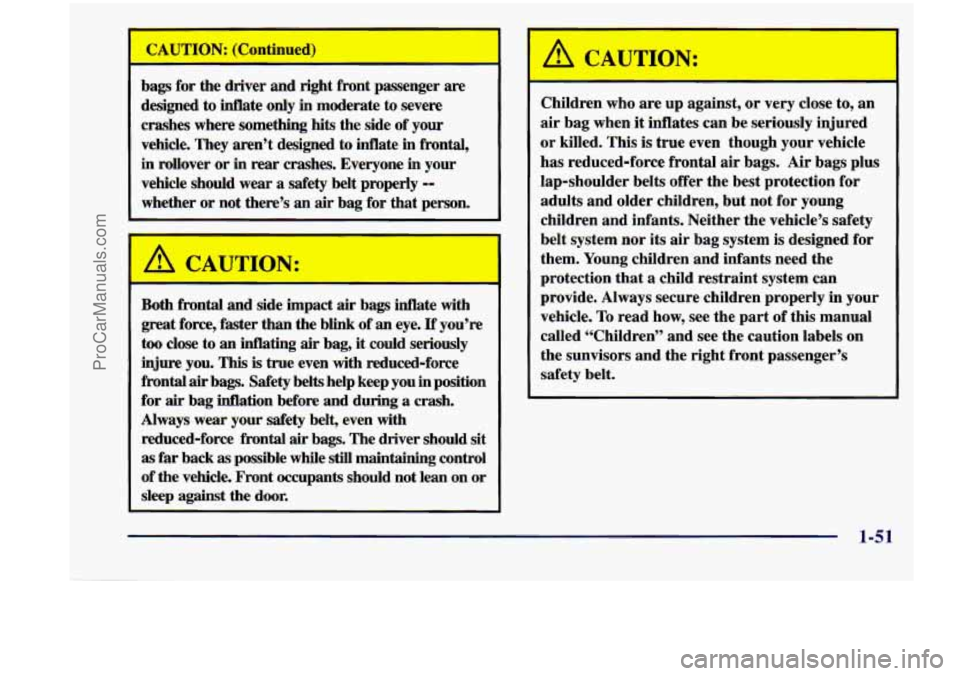
bags for the drLa’ and right front passenger are
designed to inflate
only in moderate to severe
crashes where something
hits the side of your
vehicle. They aren’t designed to inflate
in frontal,
in rollover or in rear crashes. Everyone in your
vehicle should
wear a safety belt properly --
whether or not there’s an air bag for that person.
Both frontal and side impact
air bags inflate with
great force, faster than the blink of an eye. If you’re
too close to an inflating air bag, it could seriously
injure you. This is true even with reduced-force
frontal
air bags. Safety belts help keep you in position
for
air bag inflation before and during a crash.
Always wear your safety belt, even with
reduced-force frontal
air bags. The driver should sit
as far back as possible while still maintaining control
of the vehicle. Front occupants should not lean on or
sleep against the door. Children
who are up against,
or very close to, an
air bag when it inflates can be seriously injured
or killed. This
is true even though your vehicle
has reduced-force frontal
air bags. Air bags plus
lap-shoulder belts offer the best protection for
adults and older children, but not for young
children and infants. Neither the vehicle’s safety
belt system nor
its air bag system is designed for
them. Young children and infants need the
protection that a child restraint system can
provide.
Always secure children properly in your
vehicle.
To read how, see the part of this manual
called “Children” and see the caution labels on
the sunvisors and the right front passenger’s
safety belt.
1-51
ProCarManuals.com
Page 73 of 474
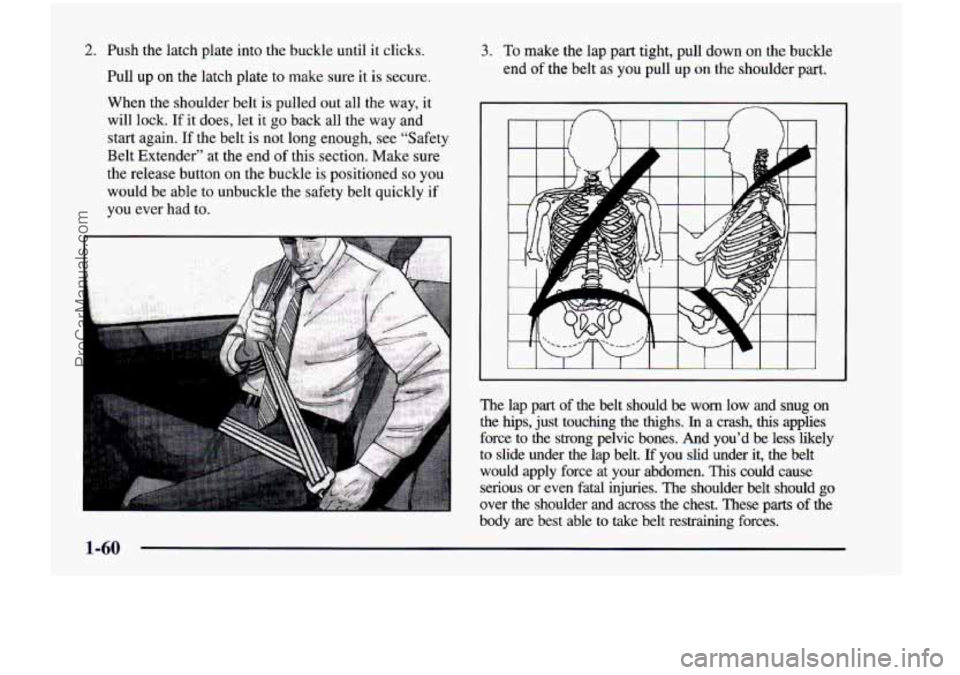
2. Push the latch plate into the buckle until it clicks.
Pull up
on the latch plate to make sure it is secure.
When the shoulder belt
is pulled out all the way, it
will lock. If it does, let it go back all the way and
start again. If the belt
is not long enough, see “Safety
Belt Extender” at the end
of this section. Make sure
the release button on the buckle is positioned
so you
would be able to unbuckle the safety belt quickly
if
you ever had to.
3. To make the lap part tight, pull down on the buckle
end
of the belt as you pull up on the shoulder part.
n n
I I I I
The lap part of the belt should be worn low and snug on
the hips, just touching the thighs. In a crash, this applies
force to the strong pelvic bones. And you’d be less likely \
to slide under the lap belt. If you slid under it, the belt \
would apply force at your abdomen.
This could cause
serious or even fatal injuries. The shoulder belt should go
over the shoulder and across the chest. These
parts of the
body are best able to take belt restraining forces.
ProCarManuals.com
Page 79 of 474

Center Passenger Position
(Bucket Seat)
Lap Belt
If your vehicle has bucket seats, someone can sit in the
center position bucket seat. When you sit in the center position bucket seat, you
have a lap safety belt which has
a retractor.
1. Pick up the latch plate and, in a single motion, pull
the belt across you. Don’t let it get twisted.
2. Push the latch plate into the buckle until it clicks. If
the belt stops before it reaches the buckle, let it go
back all the way and start again. Pull up on the latch
plate to make sure it
is secure.
3. Feed the lap belt into the retractor to tighten it.
1-66
ProCarManuals.com
Page 80 of 474
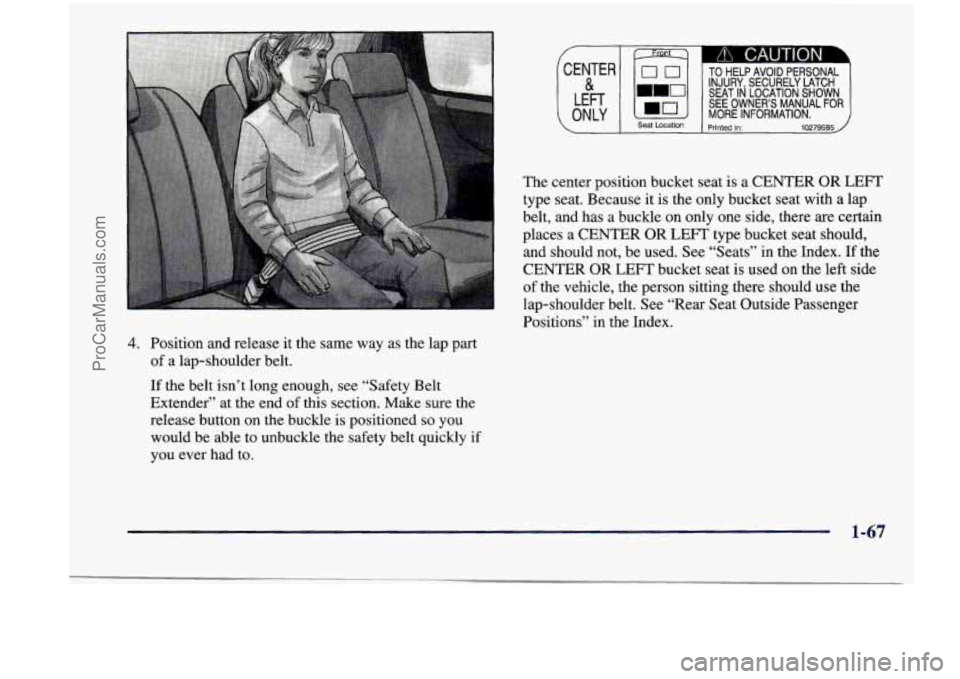
4. Position and release it the same way as the lap part
of a lap-shoulder belt.
If the belt isn’t long enough, see “Safety Belt
Extender” at the end
of this section. Make sure the
release button on the buckle is positioned
so you
would be able to unbuckle the safety belt quickly if
you ever had to.
TO HELP AVOID PERSONAL
INJURY SECURELY LATCH
SEAT
Id LOCATION SHOWN SEE OWNER’S MANUAL FOR MORE INFORMATION. Seat Location I Printed in: 10279595
The center position bucket seat is a CENTER OR LEFT
type seat. Because it is the only bucket seat with a lap
belt, and has a buckle on only one side, there are certain
places
a CENTER OR LEFT type bucket seat should,
and should not, be used. See “Seats” in the Index.
If the
CENTER OR LEFT bucket seat is used on the left side
of the vehicle, the person sitting there should use the
lap-shoulder belt. See “Rear Seat Outside Passenger
Positions” in the Index.
1-67
ProCarManuals.com
Page 81 of 474
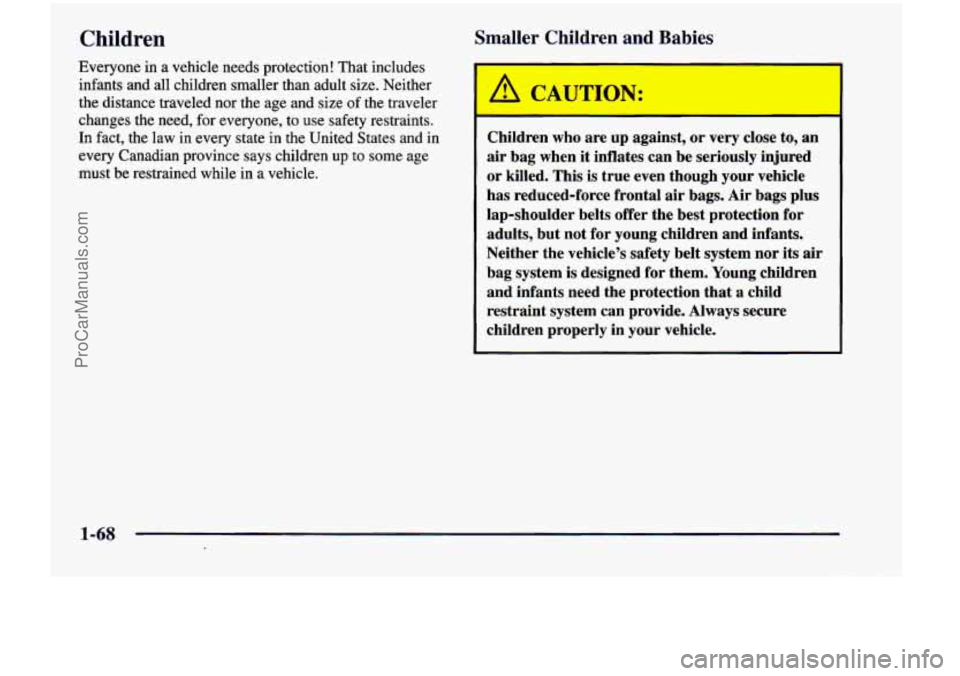
Children Sma'' -r Ch" dren and Babies
Everyone in a vehicle needs protection! That includes
infants and all children smaller than adult size. Neither
the distance traveled nor the age and size of the traveler
changes the need, for everyone, to use safety restraints.
In fact, the law
in every state in the United States and in
every Canadian province says children
up to some age
must
be restrained while in a vehicle.
' A -AUTION:
Children who are up against, or very close to, an
air bag when it inflates can be seriously injured
or killed. This is true even though your vehicle
has reduced-force frontal air bags.
Air bags plus
lap-shoulder belts offer the best protection for
adults, but not for young children and infants.
Neither the vehicle's safety belt system nor its air
bag system is designed
for them. Young children
and infants need the protection that a child
restraint system can provide. Always secure
children properly in your vehicle.
1-68
ProCarManuals.com
Page 82 of 474
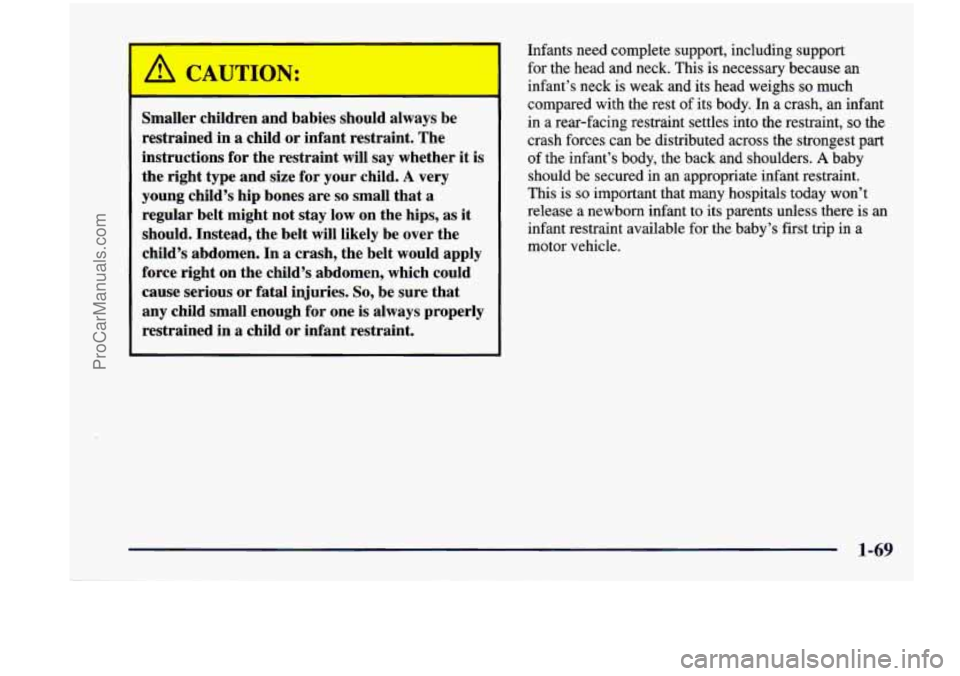
--
Smaller children and babies should always be
restrained
in a child or infant restraint. The
instructions for the restraint will say whether it is
the right type and size for your child.
A very
young child’s hip bones are
so small that a
regular belt might not stay
low on the hips, as it
should. Instead, the belt will likely be over the
child’s abdomen. In a crash, the belt would apply
force right on the child’s abdomen, which could
cause serious or fatal injuries.
So, be sure that
any child small enough for one is always properly
restrained in a child or infant restraint.
Infants need complete support, including support
for the head and neck. This is necessary because an
infant’s neck is weak and its head weighs
so much
compared with the rest of its body. In a crash,
an infant
in a rear-facing restraint settles into the restraint,
so the
crash forces can be distributed across the strongest part of the infant’s body, the back and shoulders.
A baby
should be secured in an appropriate infant restraint.
This is
so important that many hospitals today won’t
release a newborn infant to its parents unless there
is an
infant restraint available for the baby’s first trip in a
motor vehicle.
ProCarManuals.com